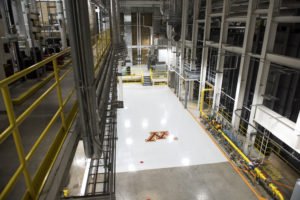UMN Energy Plant Wins Sustainable Minnesota Construction Association Award
By Rachel Leber
MINNEAPOLIS — The University of Minnesota (UMN) in Minneapolis just completed a project so green that it won construction firm Adolfson & Peterson’s (AP) one of many awards at the Minnesota Construction Association (MCA) 23rd Annual Awards of Excellence Gala on Jan. 31.
The project included the renovation of the 104-year-old Main Energy Plant to add cutting-edge “co-generation” combined heat and power generation (CHPP) equipment to create a multi-functional building. The facility is 83 percent energy efficient (more than double the efficiency of a coal-fired power plant). The features of the power plant project are so unique and impressive, they won Adolfson & Peterson the MCA Award for Excellence for Green/Sustainable Project.

The new Main Energy Plant is connected to the Gopher substation as well as the university’s utility system, and generates electric power and steam for the Minneapolis campus. Fueled by natural gas, the Main Energy Plant will save the university an estimated net $2 million annually in utility operating costs and is a key investment in the university’s climate action plan to reduce campus emissions in half by the year 2020.
“The Main Energy Plant allows the Twin Cities to operate as an energy island so that critical university services at hospitals, clinics and research facilities can be maintained if there are external outage events,” said Jerome Malmquist, director of Energy Management at UMN, in a recent statement.
The updates on the main energy plant at UMN were made possible by a one-time $2 million rebate given to the school by the CenterPoint Energy Conservation Improvement Program. In addition, the UMN’s new Main Energy Plant received $10 million from the state in a 2012 bonding bill. The project, under regulation from the Minnesota Pollution Control Agency, began in early 2015.
UMN reinvested in the former Old Main Heating Plant to replace the old boilers with a new 22.8-megawatt combustion turbine and heat recovery system. While operating, it reduces the university’s net carbon footprint by an estimated 10 to 13 percent and will provide the university with a more reliable source of energy.
During the conversion of UMN’s old steam plant to the new state-of-the-art CHPP) required unique construction and installation solutions during the design on the East Bank site, according to a university statement from 2017. Permitting and construction phases included the need for significant hazardous material abatement, approval for the cliffside location overlooking a national scenic river and park and its placement in the middle of a dense urban area.
“The Main Energy Plant marries a historic site and decommissioned plant with world-class technology and environmental stewardship to support the University’s long-term research mission,” said Mike Berthelsen, vice president of University Services, in a statement. “This is an exciting step that allows us to lessen our carbon footprint, while ensuring continuity of operations to campus and saving the University money.”
During its construction, builders began placement of equipment for chilled water production so the plant can eventually grow to a full-service utility that will provide chilled water for air conditioning.The plant went commercial on Nov. 17, 2017.

